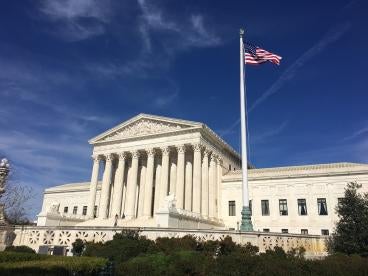Greetings, Court Fans!
Well, we’d hoped to have last week’s update out by Friday, but guess who had other plans? Virginia Katherine Roth, born Thursday, June 13, 2019. Congratulations, Dave! (Nice timing, Virginia.) Since Virginia was born, the Supreme Court has handed down four more opinions (two of which bear her name!): Gamble v. United States (No. 17-646), reaffirming the “separate sovereigns” exception to the Double Jeopardy Clause; Manhattan Community Access v. Halleck (No. 17-1702), holding that a private nonprofit that runs a public-access TV channel is not a state actor that can be sued for violating the First Amendment; Virginia Uranium v. Warren (No. 16-1275), concluding that a Virginia law banning uranium mining is not preempted by the Federal Atomic Energy Act; and Virginia House of Delegates v. Bethune-Hill (No. 18-281), dismissing a racial gerrymandering appeal for lack of standing. The Court also copped out and GVR’d Klein v. Oregon Bureau of Labor & Industries (No. 18-547), another “Christian baker” case, remanding to the Oregon Court of Appeals for further consideration in light of Masterpiece Cakeshop v. Colorado Civil Rights Comm’n (2018). We’ll have more on these decisions toute de suite (and we expect several more on Thursday), but without further ado, you’re owed last week’s summaries.
We’ve remarked a few times about the unusual matchups in split decisions lately, and Return Mail Inc. v. U.S. Postal Service (No. 17-1594), provides yet another example of strange bedfellows this term. Justice Sotomayor joined (and wrote for) the Court’s conservatives in a 6-3 decision holding that government entities (unlike private entities and individuals) can’t challenge the validity of an issued patent in the Patent Trial and Appeal Board.
The case involved a U.S. Postal Service challenge of a patent awarded to Return Mail for a method of processing undeliverable mail. (It doesn’t involve the incinerator, which might run into an obviousness problem.) After multi-front battles over patentability in the Patent Trial and Appeal Board and the lower federal courts, the Supreme Court granted cert on a narrow question: Whether a federal agency is a “person” with the right to challenge a patent in the Patent Trial and Appeal Board, as created in the America Invents Act of 2011 (AIA).
Neither the AIA nor the broader Patent Act defines a “person.” Justice Sotomayor noted that, absent a clear statutory definition, the Court follows a longstanding canon of statutory construction presuming that the definition of a “person” does not include a government or its agencies. While many of the cases employing that canon also involve the presumption against assuming that the federal government has waived its sovereign immunity, Sotomayor noted that the canon applies equally when the government is not a defendant. With the presumption against government personhood in mind, Justice Sotomayor looked more broadly for evidence suggesting whether Congress intended to count the government as a person. She turned to the Dictionary Act of 1947, which basically tells courts to read the dictionary if an act doesn’t define a term. And lo and behold, the dictionary doesn’t include the federal government in its definition of “person[s].” And with that, a majority concluded that governmental entities are not “persons” with the right to challenge patents under the AIA.
The dissenters, led by Justice Breyer, argued that it makes no sense for Congress to let everyone except the government participate in AIA review proceedings. The government can obtain patents, sue others for infringement, and be forced to defend its patents against AIA challenges by others. In that broader context, he saw no reason to think that Congress declined to give federal agencies the power to invoke AIA review proceedings against others. The majority didn’t buy that big-picture structural view, concluding that Congress could have wanted the government to be able to do some things but not others: to get a patent, or to sue for infringement, but not to initiate AIA review proceedings. And while the dissent thought it unfair to deprive the government of a tool that the AIA gave to all other alleged infringers, the majority noted that the government has singular advantages to balance this disadvantage. Unlike private parties, the government cannot be enjoined in a patent suit and its exposure to monetary damages is limited. "Because federal agencies face lower risks, it is reasonable for Congress to have treated them differently," the majority said.
So, after Return Mail, the federal government can still assert the invalidity of a patent, but it needs to do so in federal court, instead of before the PTAB.
Next up, in Quarles v. United States (No. 17-778), the Court addressed a first-year criminal law final exam question: Whether a person has committed “burglary,” under the generic, common-law understanding, if he only forms the intent to commit a crime after entering and remaining in a dwelling, as opposed to at the exact moment of entry. A unanimous Court concluded that, yes, that’s still burglary and held that the definition of “burglary,” as used in the Armed Career Criminal Act (“ACCA”), includes “unlawfully remain[ing] in a building or structure . . . when a person forms the intent to commit a crime at any time.”
The petitioner, Jamar Quarles, had pleaded guilty to being felon in possession of a firearm in violation of 18 U.S.C. § 922(g)(1). Quarles had at least three prior convictions which prosecutors argued qualified as violent felonies under the ACCA. Quarles countered that one of these—a conviction for third-degree home invasion—should not qualify because the Michigan statute under which he was convicted had a broader definition of burglary than the ACCA. Under the Michigan statute, a person committed third-degree home invasion by forming the intent to commit a crime at any time while present in a building; in contrast, Quarles argued, the ACCA, as interpreted by the Court’s 1990 decision in Taylor v. United States, required a person to form the intent to commit a crime at the time of entering the building. The District Court rejected Quarles’s argument, as did the Sixth Circuit.
Writing for a unanimous Court, Justice Kavanaugh began by describing in tedious careful detail the facts surrounding the discovery of the firearm in Quarles’s possession as well as the facts surrounding not just the burglary conviction but several of Quarles’s other convictions—all of which involved disturbing incidents of domestic violence. (Translation: Don’t feel bad that Quarles is going to have his 15-year mandatory minimum sentence upheld.) Turning to the question presented, Justice Kavanaugh concluded it was unlikely that Congress had intended burglary under the ACCA to exclude burglars who formed the intent to commit a crime after entering—particularly in light of Congress’s rationale that burglary was inherently dangerous in that it created the possibility of a violent confrontation between the offender and another in the building. The risk of such confrontation, Kavanaugh reasoned, did not turn on the precise moment of the burglar’s formation of an intent to commit a crime. Kavanaugh also noted that, under Quarles’s interpretation of the ACCA, many states’ burglary statutes would be broader than § 924(e), which would “defeat Congress’ stated objective of imposing enhanced punishment on armed career criminals who have three prior convictions for burglary or other violent felonies.”
Justice Thomas concurred in the judgment and in Kavanaugh’s opinion, but wrote separately to reiterate his opposition to the “categorical approach” in cases involving the enumerated-offenses clause of the ACCA. In his view, rather than comparing the statutory definition of Quarles offense with the “judicially created ideal of burglary,” it would make a lot more sense to just look at the “reality of petitioner’s actual crime: Petitioner attempted to climb through an apartment window to attack his ex-girlfriend.” Thomas rejected the reasons provided for the categorical approach, calling it a “misguided attempt to avoid Sixth Amendment problems” and not a necessary interpretation of ACCA’s text.
Finally, we bring you Parker Drilling Management Services v. Newton (No. 18-389), a case you probably haven’t been holding your breath for, unless you happen to make a living litigating matters involving the Outer Continental Shelf (“OCS”). Nevertheless, it is always nice to see the Court find unanimity, particularly in a class-action case. The plaintiff, Newton, worked for Parker Drilling Management Services (“Parker”) on drilling platforms off the coast of California. Newton worked 14-days at a time on the platform. He was paid quite well for the 12 hours a day he worked, but he was not paid at all for the 12 hours he was not actively working, even though he was on standby and not permitted to leave the platform. He filed a class action lawsuit alleging violations of California wage-and-hour and related laws, alleging that Parker’s failure to pay him for the standby time was unlawful. Parker moved to dismiss, arguing that under the Outer Continental Shelf Lands Act (“OCSLA”), California wage and hour laws did not apply on the OCS and therefore Newton had no cause of action. The District Court agreed, reasoning that the federal Fair Labor Standards Act (“FLSA”) provided a comprehensive wage-and-hour scheme that left no gaps for state law to fill, but the Ninth Circuit reversed.
The Court reversed right back, in an opinion by Justice Thomas. The OCSLA makes clear that federal law is the only source of law on the OCS but permits state law to be treated as relevant federal law where it is “applicable and not inconsistent with” other federal law. Newton argued that this standard permits state law to apply any time it is relevant to the subject matter at hand and where compliance with both federal and state law is possible. Since FLSA generally does not preempt more restrictive state laws, Newton argued it met this test. While the Court felt the issue presented a close question, it ultimately disagreed, concluding that the test advocated by plaintiff was akin to a preemption analysis and would permit state law to apply almost all of the time, an approach inconsistent with the entire thrust of the OCSLA, which made clear that only federal law governs on the OCS. Thus, the Court reasoned, if there is federal law on an issue, it would be “inconsistent” to apply state law. Accordingly, the OCSLA only permits the application of state law on the OCS when there is a gap in federal law. Here, there was none, so Newton’s California law claims could not proceed.
That brings us up to speed on opinions (as of 10:00 this morning). With four more cases decided today, the Court still has to get through twenty more before the end of June, so you’ll be hearing from us quite a bit from here on out.





 i
i

